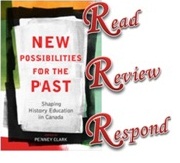Read-Review-Respond Blog II: "Historical Thinking in the Museum"
15 November 2012 - 1:11pm
 While many of the chapters in Penney Clark's edited collection, New Possibilities for the Past: Shaping History Education in Canada, discuss classroom learning, Viviane Gosselin's chapter, “Historical Thinking in the Museum: Open to Interpretation” challenges readers to think about history education in a museum setting. Gosselin reminds readers that “museums are one of the few public institutions mandated to facilitate lifelong learning about the collective past” (246). When people are no longer in school, they will still encounter history in museums. Museums are uniquely challenging learning spaces because they are sites of informal history learning: the museum experience is less structured than the classroom, and museum educators do not have as much time to teach and assess learners as school teachers do.Visitors also respond to a diverse range of teaching strategies, and they also represent a variety of ages, backgrounds, and prior knowledge.
While many of the chapters in Penney Clark's edited collection, New Possibilities for the Past: Shaping History Education in Canada, discuss classroom learning, Viviane Gosselin's chapter, “Historical Thinking in the Museum: Open to Interpretation” challenges readers to think about history education in a museum setting. Gosselin reminds readers that “museums are one of the few public institutions mandated to facilitate lifelong learning about the collective past” (246). When people are no longer in school, they will still encounter history in museums. Museums are uniquely challenging learning spaces because they are sites of informal history learning: the museum experience is less structured than the classroom, and museum educators do not have as much time to teach and assess learners as school teachers do.Visitors also respond to a diverse range of teaching strategies, and they also represent a variety of ages, backgrounds, and prior knowledge.
History museums must find a way to engage visitors in a short amount of time, without neglecting the complexity of historical knowledge. Just as classroom teachers are challenged to present content in a way that is engaging and relevant, history museums must also address issues of “social relevance and institutional responsibility” (245) when they present exhibits about their individual collections. A focus on historical thinking threads its way throughout the chapters of Clark's collection, and Gosselin also engages with this idea. She encourages museums to use methods of historical thinking in history exhibits, including involving visitors in the process of history.
Gosselin suggests that despite the challenges, history museums must avoid simplistic interpretations that fail to engage with historical thinking. She suggests that history museums would be well-served by developing a shared understanding of historical thinking, and using that knowledge to encourage visitors to reach their own conclusions and interpretations. She explains that this method will not “eliminate the role of museums as sites of memory,” but rather, “make museums public spaces where visitors can posit and contemplate the tensions between history and memory, between the familiar and the foreign past, between previous and current ways of relating to time, space, and collectives” (259). This chapter offers an exciting vision fot history museums who choose to engage with these ideas.
Gosselin points out that many of those who create history exhibits do not have a background in history, and may be new to some of the ideas presented in this collection. Curators often have experience in the field, but designers, project managers, and other roles may come from a diverse range of professional experiences. Gosselin suggests that an early step is to educate museum staff on these issues, and encourage a shared vocabulary (255).
Gosselin goes on to suggest that in history exhibit design, it becomes less important to display one "correct" way of telling a story. She suggests that museums provide the tools visitors need to understand how a story is constructed. One example she gives is placing a selection of artifacts in front of visitors and asking what they would choose to exhibit (257). The goal is for visitors to think critically and see the history that is being presented, as well as how that history has come to be accepted. She suggests that visitors should be invited into the museological process, and should see how exhibits are constructed to convey meaning (256). Exhibits can also emphasize connection and relevance to the stories that the visitors bring with them (255). Visitors might find themselves in the history, which might create a more lasting impact.
What are some ways that history museums can facilitate historical thinking?
- Se connecter ou créer un compte pour soumettre des commentaires

